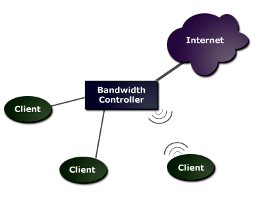Managing The Bandwidth In An I-Café
 Internet connection is the most important resource in an i-café. An i-café must have a stable Internet connection and sufficient bandwidth in order to succeed. Slow and intermittent connection when browsing or playing online games are what i-café customers hate most. Having such situation in an i-café is a surefire formula for business failure. If you have slow or intermittent connections, what can you do to make it fast and stable without subscribing to expensive plans being offered by Internet service providers (ISPs) in your area? Is there a way to use inexpensive Internet connections and still get your customers satisfied with their gaming and browsing experience in your i-cafe? This is what we call bandwidth management and in this article, I will discuss some common ways of achieving stable connection and appropriate bandwidth sharing among users in your i-café.
Internet connection is the most important resource in an i-café. An i-café must have a stable Internet connection and sufficient bandwidth in order to succeed. Slow and intermittent connection when browsing or playing online games are what i-café customers hate most. Having such situation in an i-café is a surefire formula for business failure. If you have slow or intermittent connections, what can you do to make it fast and stable without subscribing to expensive plans being offered by Internet service providers (ISPs) in your area? Is there a way to use inexpensive Internet connections and still get your customers satisfied with their gaming and browsing experience in your i-cafe? This is what we call bandwidth management and in this article, I will discuss some common ways of achieving stable connection and appropriate bandwidth sharing among users in your i-café.
DSL (Digital Subscriber Line) Internet connections for i-cafés in the Philippines are provided wired or wireless and sold in unlimited basis (meaning the amount of downloaded and uploaded data are not measured) and paid monthly by the shop owner. An area in the country is normally serviced by two (2) or more ISPs offering bandwidth subscriptions of 512Kbps (Kilobits per second) to to around 3.5Mbps (Megabits per second) at a cost of PhP995 as the lowest to as much as PhP8,000 per month. Depending on the number of workstations in an i-café, the choice of ISP and the Internet connection varies from one shop to another but the objective is always to get a reliable and fast connection through a workstation.
Having a back-up Internet connection is now a must for i-cafés and using wireless USB modem as back-up is what I recommend for small shops. For bigger ones who need and can afford a second ISP connection, managing the bandwidth that a workstation gets is more challenging. For both regular operation and when one of its Internet connections get down, the regular set-up having an ordinary signal router and switch is not enough to handle the two or more Internet feeds that big i-cafés have.
For the technically capable, there are available free open-source software like Squid and PFSense that they can use to manage the bandwidth in their i-cafés. For others, there are available hardware called Multi-WAN Routers that can handle automatic fail-over, load balancing, and bandwidth shaping in an i-café. I shall discuss more about these terminologies in my future blogs.




Latest Feedbacks